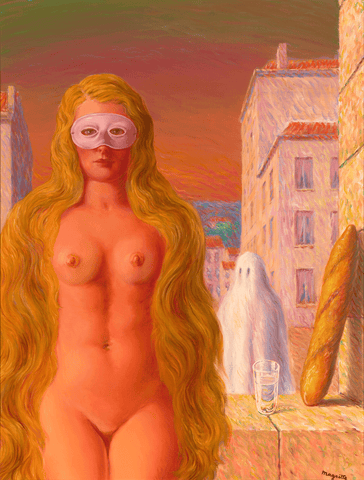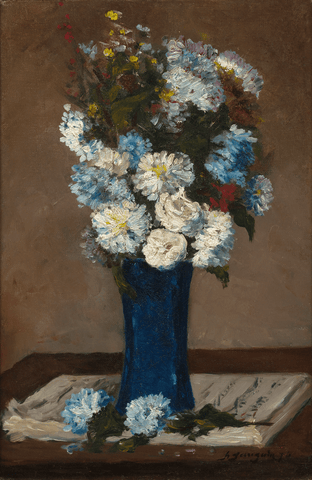Both illustrator and painter, Maxfield Parrish is recognized today for his considerable influence on
American art and distinct artistic style incorporating vibrant hues into his Neoclassical-inspired works. His diverse oeuvre ranged from book illustrations to advertisements to murals, and his works were beloved by an entire generation. Read on to learn about Maxfield Parrish's life, career and long-lasting influence on American art.

Maxfield Parrish
Early Life and Training
Maxfield Parrish was born in Philadelphia, Pennsylvania on July 25th, 1870. Raised in a Quaker society, he was encouraged to pursue an artistic path from a young age. His father was also an artist, working as a painter and etcher and exhibiting his works across the United States and Europe. The elder Parrish's artistic career allowed Maxfield to travel through Europe at a young age, exposing him to the architecture and painting techniques that would inspire his future works.
Upon returning to America, Maxfield Parrish studied architecture at Haverford College and then later fine art at the Pennsylvania Academy of Fine Arts. While still a student, his professors recognized his innate talent, and Maxfield Parrish’s paintings were regarded as some of the most successful in his class.
After graduation, Parrish shared an art studio with his father, who greatly supported his son's artistic goals and encouraged him to seek further education and hone his skills at the Drexel Institute of Art. His artistic career was launched by a commission to illustrate L. Frank Baum's
Mother Goose in Prose in 1897, after which Parrish earned numerous commissions illustrating for other texts and magazines such as
Harper's,
Hearst's,
Collier's and
Life.
The Golden Age of Illustration
Parrish applied his artistic training with great success in his career as an illustrator, winning his first magazine cover commission for the Harper's Bazaar Easter edition in 1895, which was positively received and led to further commissions for Parrish. In the following years, Parrish created advertisements for brands including General Electric and continued to illustrate covers for popular publications of the day.
He also was a successful and sought-after muralist. Works by Parrish decorated the walls of important buildings across the country, from New York City to San Francisco. Parrish also earned several lucrative commissions for children's books beyond
Mother Goose in Prose, and he created illustrations for such titles as
Arabian Nights and Eugene Field's
Poems of Childhood.
Returning to Nature
In the latter portion of his career, Parrish chose to forgo the figures that propelled his works into the spotlight and instead focus on the beauty of nature. The 1930s were a formative time for the artist in which he began shifting away from producing illustrations and figurative works to instead fully embrace his love of nature. By 1935, he was exclusively painting landscapes, and his work within this genre was marked by grandeur and luminosity.
Parrish lived in Cornish, New Hampshire for the majority of his life, allowing the natural world around him to inspire these later works. His home in this rural town was a 45-acre estate called “the Oaks,” which Parrish designed himself and continued to renovate many times. He only stopped painting in 1962 when arthritis in his hands prevented his work.
Process
Parrish had a revolutionary understanding of color and was able to perfect a vibrancy of hues never before achieved on canvas, with colors so unique, they appeared to have been lit from within. He achieved such luminosity in part through the use of glazes, applying alternating bright layers of translucent glaze separated by varnish over his base composition, a process that required weeks of work. He developed a particular shade of blue that he often used in his skies that became so famous that it is known now as Parrish blue, and the shade is still used and admired by artists today.
Additionally, Parrish never mixed white paint with his colors because it could result in a duller, chalky color. He would instead carefully blend out his pigments across the painting surface. This process created a soft fading effect and had the added benefit of utilizing the white of the board itself, allowing it to peek through and lighten the pigments without weakening them.
Influence and Legacy
Parrish's impact on American art and illustration was profound. Iconic pop artist
Andy Warhol was an avid collector of Parrish's work, and the renowned illustrator
Norman Rockwell greatly admired Parrish. He was fortunate enough to be both commercially successful and critically acclaimed as an artist during his lifetime, and it seemed his popularity knew no bounds.
At the very peak of his career in 1925, an estimated one in four American homes displayed a print by Parrish, and his 1922 painting
Daybreak was the most sold art print of the entire 20th century. Parrish remains beloved today due to the timelessness of his dreamlike landscapes, and his long-term influence on American popular culture has been profound.
Variations on Daybreak were used on a Moody Blues album cover, in a Michael Jackson music video, a Bloom County cartoon collection and the movie poster for The Princess Bride. In 2001, Parrish was featured in a United States Post Office commemorative stamp series honoring American illustrators, cementing his legacy as one of the great American painters.
You can explore M.S. Rau's website to discover our entire collection of
American art or to learn more about the
history of American Illustration.











